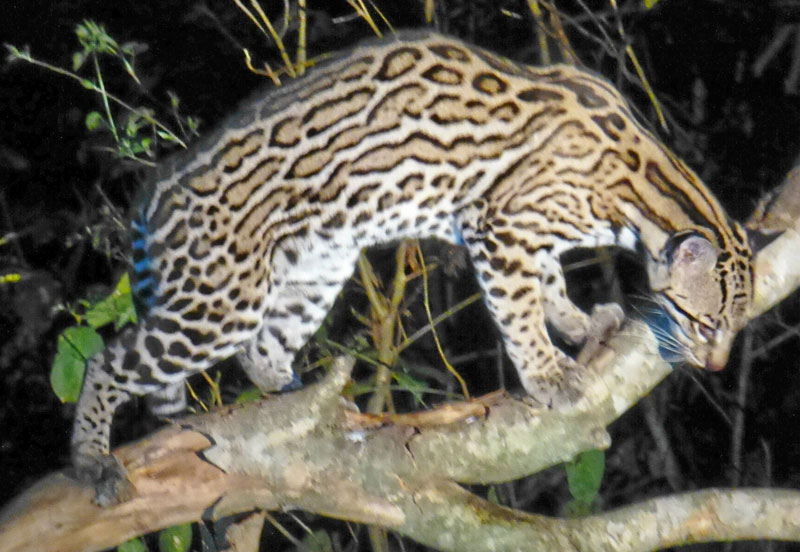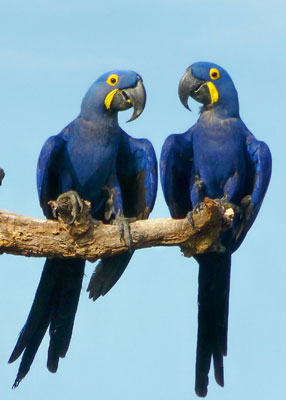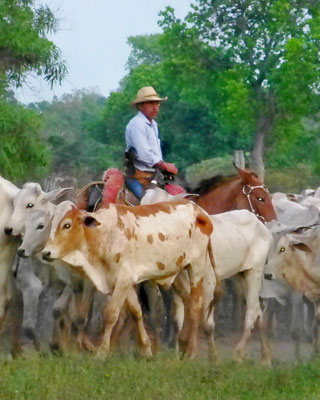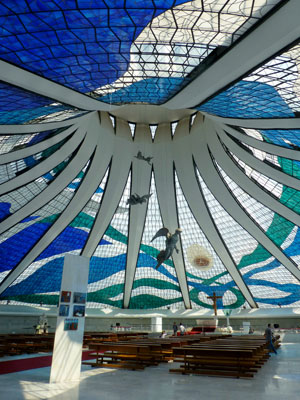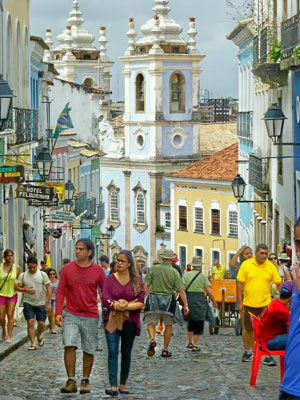The Pantanal, Brasilia and Salvador
This item appears on page 54 of the March 2015 issue.
(2nd of 3 parts on Brazil)
The inclusion of the amazing Pantanal was one of the primary reasons I chose to travel to Brazil on a 20-day, September 2014 tour operated by the small-group adventure tour operator and longtime ITN advertiser ElderTreks.
Even before our nighttime arrival at Pousada Aquapé farm, reached by road from the ecological paradise of Bonito, which I reported on in last month’s column, I sensed that our group of 12 was in for a very special experience. I was right.
Extending from Brazil into portions of Bolivia and Paraguay, the Pantanal is approximately 18 times the size of the Florida Everglades. A portion of the Brazilian Pantanal is listed as a UNESCO World Heritage Site, and it is unique for the abundance of wildlife that can be found only in this expansive tropical wetland region.
We were visiting in the dry season, when the often-dusty landscape features open savannah dotted with sections of forest, small lakes and an expansive system of huge cattle ranches. Reportedly, there are nearly eight million head of cattle in the Pantanal at any given time.
Its ecosystem relies on the annual flood cycle, in some ways as in the Okavango Delta in Botswana. During the rainy season, in most years, up to 80% of the Pantanal is transformed into a gigantic saturated flood plain, with all wildlife, ranching and other human activities forced to adapt to the limiting conditions.
Pousada Aguapé adventures
Our home base in the southern Pantanal, Pousada Aguapé farm (phone [55] [67] 3258 1146, www.aguape.com.br), has been operated by the same family for more than 150 years.
The property is defined by lowlands, open pastures, ponds, lakes and the Aquidauana River, which is lined by lush forest. The area is a prime environment for bird-watchers, with more than 270 species recorded.
During the last 25 years, the farm has diversified its activities from a strict cattle-ranching focus to ecotourism, including a lodge and the Hyacinth Macaw Project, as well as horse breeding and the development of a school.
Our Pousada Aguapé excursions focused on the wildlife and included guided hikes, 4-wheel-drive forays, a small-boat river exploration and horseback riding. Animals we discovered included capybaras, feral pigs, armadillos, spiny anteaters, foxes, two types of monkeys, deer and an ocelot.
Among the scores of colorful birds we discovered were large Jabiru storks, huge flightless rheas (similar to small emus), owls, several types of brightly colored ornate macaws (including the striking hyacinth macaw), parrots and, my personal favorite, the alluring toucan.
Keep them doggies rollin’
Due to purely fortunate timing, we happened to be at Pousada Aguapé as a cattle drive passed through the property, stopping overnight on its 3-month journey.
Several of us walked over to their camp at daybreak to watch the cowboys break camp, pack up and begin the morning cattle drive. Our dawn stroll provided an authentic, timeless, Brazilian wild west experience with truly magical photo ops. A trip highlight, it was indicative of the many surprises visitors can encounter in the Pantanal.
On to Brasilia
Much of the following day was spent in transit, driving back to Campo Grande and meeting our flight to Brasilia, the Brazilian capital.
The day after that, the Pantanal was still in my head and I didn’t feel ready for another city. Fortunately, to the rescue came our guide Juan, who turned what could have been a lackluster day of touring into a performance. With the slightest opportunity, Juan would break into Broadway-style show tunes, finding ways to relate them to our activities. He was good!
Most North American leisure travelers do not find their way to Brasilia (city and environs, about 2.5 million), a city inaugurated in 1960. The founding of the city at its inland location was the brainchild of Juscelino Kubitschek, Brazil’s most popular, progressive and visionary president.
The intent of the urban-project designer and architect Lúcio Costa was for the new capital to resemble an airplane when viewed from the air, although most people think it more closely resembles a bird with wings spread.
Many of the most noteworthy buildings, including a number of the civic structures, are the handiwork of Brazilian architect Oscar Niemeyer. He was perhaps most famous for his use of abstract forms and curves, which are features of most of his creations in this city. His style sparked considerable controversy at the time.
Our city wanderings began with a fabulous view over Brasilia and its satellite cities from the Torre de TV viewing tower. Our subsequent stops included the Santuário Dom Bosco, revealing staggering walls of blue stained glass, and the Banco do Brasil Cultural Centre.
I really enjoyed the modernistic Catedral Metropolitana, Brasilia’s only cathedral, with its subterranean Niemeyer design featuring sweeping panes of stained glass.
Also of significance was the Memorial JK, another Niemeyer design, containing a highly educational museum chronicling the life and times of President Kubitschek.
Salvador excites
From Brasilia, we flew to pulsating Salvador, the largest city (pop., 3.5 million, city and surrounds) on Brazil’s northeastern coast and the capital of the state of Bahia.
Situated on huge All Saints Bay, it was the first colonial capital of Brazil and is one of the oldest cities in the Americas, dating to 1549. Salvador is a major port, strategically situated in the heart of a rich agricultural and industrial region of Bahia.
The city is often referred to as “Brazil’s happiness capital,” due to its reputation of always having a party going on somewhere. This includes holding what is reported to be the world’s largest annual carnival.
Its ultrafestive atmosphere is largely due to the influence of the thriving Afro-Brazilian culture. Salvador features both formal and informal Afro-Brazilian music-and-dance scenes, often accented by bright costumes.
Exploring Salvador
Salvador is divided by an escarpment that separates the city into “Lower Town,” the port area and neighborhoods along the bay, and “Upper Town,” the rest of the city, where the Historic Centre is located.
Across from the entrance to the lively Mercado Modelo, in the port area, the 90-meter-tall Elevador Lacerda has transported locals and visitors between the two parts of the city since 1873, undergoing many upgrades over the years.
Our day and evening touring centered around the Historic Centre, frequently referred to as the Pelourinho. This hilly area, declared a UNESCO World Heritage Site in 1985, is known for its cobblestone streets and striking Portuguese-colonial architecture that dates from the 17th to 19th centuries.
Our small and quaint accommodation, Pousada do Pilar (http://pousadadopilar.com), with double rooms from $70 per night, featured charming balconies looking over the port. From the property, we could easily walk to all Pelourinho attractions, including churches, studios, galleries, shops and restaurants.
Our Salvador roamings featured the port, the Mercado Modelo and several important churches, among them the ornate São Francisco Church, where, by chance, we intercepted and then drifted along with a celebratory Saint Francis of Assisi procession.
We also were the beneficiaries of a most impressive evening performance of Afro-Brazilian dance at a small Pelourinho theater.
Small-group travel
Next month I’ll describe the final portion of my partially hosted journey to Brazil, including Manaus, the Amazon and, our tour’s finale, Rio.
For details of this comprehensive tour and information about small-group adventure travel around the world, contact ElderTreks (597 Markham St., Toronto, ON, M6G 2L7, Canada; 800/741-7956, www.eldertreks.com).

